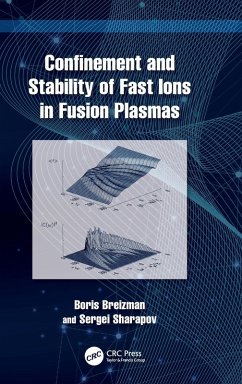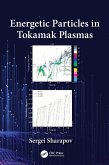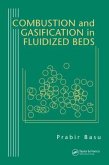- Gebundenes Buch
- Merkliste
- Auf die Merkliste
- Bewerten Bewerten
- Teilen
- Produkt teilen
- Produkterinnerung
- Produkterinnerung
This book explores the outstanding and rather novel diagnostics of the fast ions and fast ion-driven instabilities coupled to modern theory of near-critical nonlinear wave-particle systems with the particle source and wave damping.
Andere Kunden interessierten sich auch für
![Energetic Particles in Tokamak Plasmas Energetic Particles in Tokamak Plasmas]() Sergei SharapovEnergetic Particles in Tokamak Plasmas157,99 €
Sergei SharapovEnergetic Particles in Tokamak Plasmas157,99 €![Combustion and Gasification in Fluidized Beds Combustion and Gasification in Fluidized Beds]() Prabir BasuCombustion and Gasification in Fluidized Beds222,99 €
Prabir BasuCombustion and Gasification in Fluidized Beds222,99 €![Fuel Cell Technology Handbook Fuel Cell Technology Handbook]() Gregor Hoogers (ed.)Fuel Cell Technology Handbook212,99 €
Gregor Hoogers (ed.)Fuel Cell Technology Handbook212,99 €![Industrial Uses of Biomass Energy Industrial Uses of Biomass Energy]() Industrial Uses of Biomass Energy78,99 €
Industrial Uses of Biomass Energy78,99 €![Introduction to Energy Technologies for Efficient Power Generation Introduction to Energy Technologies for Efficient Power Generation]() Alexander V. DimitrovIntroduction to Energy Technologies for Efficient Power Generation60,99 €
Alexander V. DimitrovIntroduction to Energy Technologies for Efficient Power Generation60,99 €![Handbook of Storage Tank Systems Handbook of Storage Tank Systems]() Wayne B. GeyerHandbook of Storage Tank Systems300,99 €
Wayne B. GeyerHandbook of Storage Tank Systems300,99 €![Renewable Energy Systems Renewable Energy Systems]() Fang Lin LuoRenewable Energy Systems326,99 €
Fang Lin LuoRenewable Energy Systems326,99 €-
-
-
This book explores the outstanding and rather novel diagnostics of the fast ions and fast ion-driven instabilities coupled to modern theory of near-critical nonlinear wave-particle systems with the particle source and wave damping.
Produktdetails
- Produktdetails
- Verlag: CRC Press
- Seitenzahl: 172
- Erscheinungstermin: 5. März 2025
- Englisch
- Abmessung: 240mm x 161mm x 14mm
- Gewicht: 429g
- ISBN-13: 9781032185330
- ISBN-10: 1032185333
- Artikelnr.: 71597826
- Herstellerkennzeichnung
- Libri GmbH
- Europaallee 1
- 36244 Bad Hersfeld
- gpsr@libri.de
- Verlag: CRC Press
- Seitenzahl: 172
- Erscheinungstermin: 5. März 2025
- Englisch
- Abmessung: 240mm x 161mm x 14mm
- Gewicht: 429g
- ISBN-13: 9781032185330
- ISBN-10: 1032185333
- Artikelnr.: 71597826
- Herstellerkennzeichnung
- Libri GmbH
- Europaallee 1
- 36244 Bad Hersfeld
- gpsr@libri.de
Boris Breizman is an expert in theoretical plasma physics. His research deals with linear and nonlinear waves in plasmas, with applications to magnetic fusion, beam-plasma interactions, space plasma, plasma-based propulsion, and laser-plasma interactions. He held the positions of Leading Scientist at the Budker Institute of Nuclear Physics (1986-1992) and Professor at Novosibirsk State University (1981-1992). Since joining the Institute for Fusion Studies in 1993, Dr. Breizman has made significant new contributions to three important areas: wave-particle interaction in magnetically confined plasma, plasma propulsion project at NASA, and physics of laser-irradiated clusters. In 1998 the Czech Academy of Sciences awarded him its Ernst Mach Honorary Medal for Merit in the Physical Sciences. He is a Fellow of the American Physical Society. Sergei Sharapov is Principal Research Scientist at Culham Campus of UKAEA. He graduated in experimental nuclear physics from Moscow Physical Technical Institute in 1985, and did his PhD in physics and chemistry of plasmas at Kurchatov Institute of Atomic Energy, Moscow. Subsequently, he worked at Kuchatov IAE on the theory of nonlinear waves and energetic particle-driven Alfvén waves. In 1993, he moved to work on JET and on the spherical tokamaks START and MAST, located at the Culham Centre for Fusion Energy, UK. Dr. Sharapov's areas of interest and expertise lie in the theory, experiment, and diagnosis of energetic particles and energetic particle-driven instabilities in magnetic fusion devices.
Chapter 1: Classical Behavior of Fusion-born Alpha-particles. Chapter 2:
Wave-particle Resonant Interaction: Theory Versus Experiment. Chapter 3:
Energetic Particle-Driven Modes of Spontaneous Frequency Sweeping. Chapter
4: The Fishbones. Chapter 5: Equilibrium and Alfvén Eigenmodes in Tokamak
Plasma. Chapter 6: Drive, Damping, and Excitation Threshold for Alfvén
Eigenmodes. Chapter 7: Alfvén Cascade Modes in Reversed Magnetic Shear
Equilibria. Chapter 8: Multiple Modes and Global Transport of Energetic
Particles. Appendix A: Cubic Equation Derivation. Appendix B: Reduced Model
for the Weakly Nonlinear Fishbones. Appendix C: Flux Coordinates for
Tokamak Equilibrium. Appendix D: Radiative Damping for TAE. Appendix E:
Trapped Electron Collisional Damping for TAE. Appendix F: Wave Energy of
TAE in Numerical Assessment of the TAE.
Wave-particle Resonant Interaction: Theory Versus Experiment. Chapter 3:
Energetic Particle-Driven Modes of Spontaneous Frequency Sweeping. Chapter
4: The Fishbones. Chapter 5: Equilibrium and Alfvén Eigenmodes in Tokamak
Plasma. Chapter 6: Drive, Damping, and Excitation Threshold for Alfvén
Eigenmodes. Chapter 7: Alfvén Cascade Modes in Reversed Magnetic Shear
Equilibria. Chapter 8: Multiple Modes and Global Transport of Energetic
Particles. Appendix A: Cubic Equation Derivation. Appendix B: Reduced Model
for the Weakly Nonlinear Fishbones. Appendix C: Flux Coordinates for
Tokamak Equilibrium. Appendix D: Radiative Damping for TAE. Appendix E:
Trapped Electron Collisional Damping for TAE. Appendix F: Wave Energy of
TAE in Numerical Assessment of the TAE.
Chapter 1: Classical Behavior of Fusion-born Alpha-particles. Chapter 2:
Wave-particle Resonant Interaction: Theory Versus Experiment. Chapter 3:
Energetic Particle-Driven Modes of Spontaneous Frequency Sweeping. Chapter
4: The Fishbones. Chapter 5: Equilibrium and Alfvén Eigenmodes in Tokamak
Plasma. Chapter 6: Drive, Damping, and Excitation Threshold for Alfvén
Eigenmodes. Chapter 7: Alfvén Cascade Modes in Reversed Magnetic Shear
Equilibria. Chapter 8: Multiple Modes and Global Transport of Energetic
Particles. Appendix A: Cubic Equation Derivation. Appendix B: Reduced Model
for the Weakly Nonlinear Fishbones. Appendix C: Flux Coordinates for
Tokamak Equilibrium. Appendix D: Radiative Damping for TAE. Appendix E:
Trapped Electron Collisional Damping for TAE. Appendix F: Wave Energy of
TAE in Numerical Assessment of the TAE.
Wave-particle Resonant Interaction: Theory Versus Experiment. Chapter 3:
Energetic Particle-Driven Modes of Spontaneous Frequency Sweeping. Chapter
4: The Fishbones. Chapter 5: Equilibrium and Alfvén Eigenmodes in Tokamak
Plasma. Chapter 6: Drive, Damping, and Excitation Threshold for Alfvén
Eigenmodes. Chapter 7: Alfvén Cascade Modes in Reversed Magnetic Shear
Equilibria. Chapter 8: Multiple Modes and Global Transport of Energetic
Particles. Appendix A: Cubic Equation Derivation. Appendix B: Reduced Model
for the Weakly Nonlinear Fishbones. Appendix C: Flux Coordinates for
Tokamak Equilibrium. Appendix D: Radiative Damping for TAE. Appendix E:
Trapped Electron Collisional Damping for TAE. Appendix F: Wave Energy of
TAE in Numerical Assessment of the TAE.









